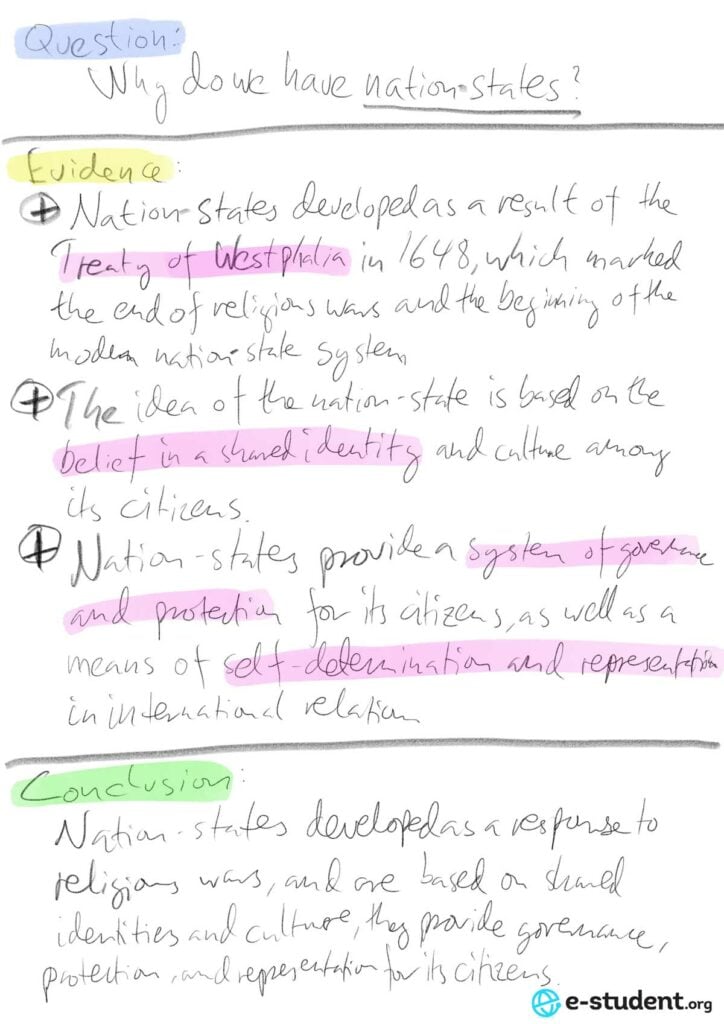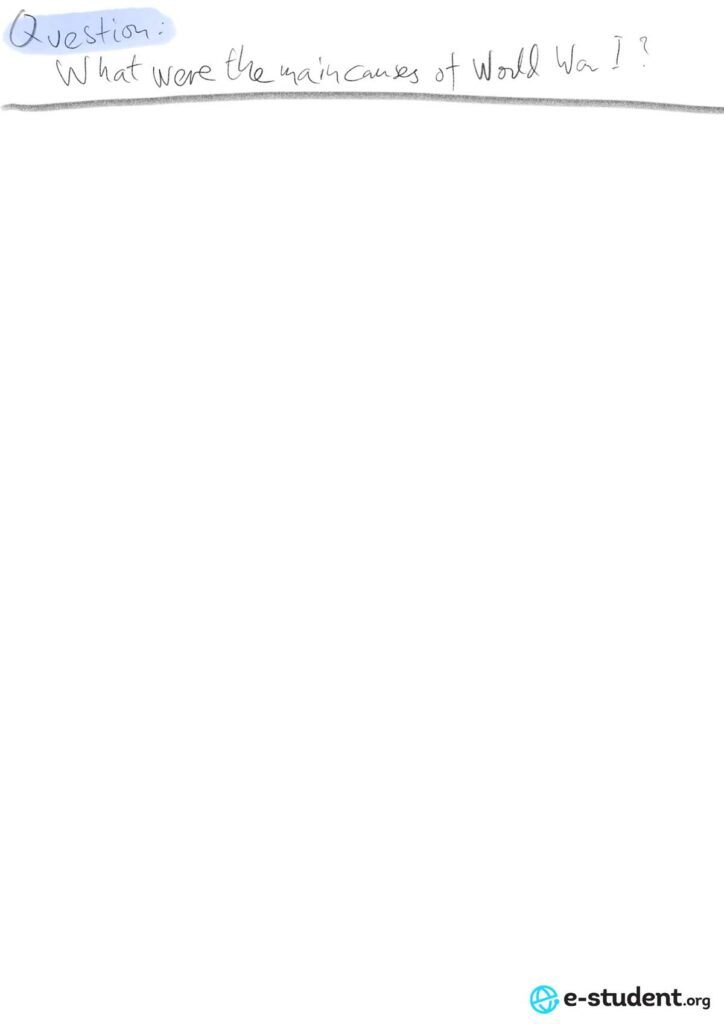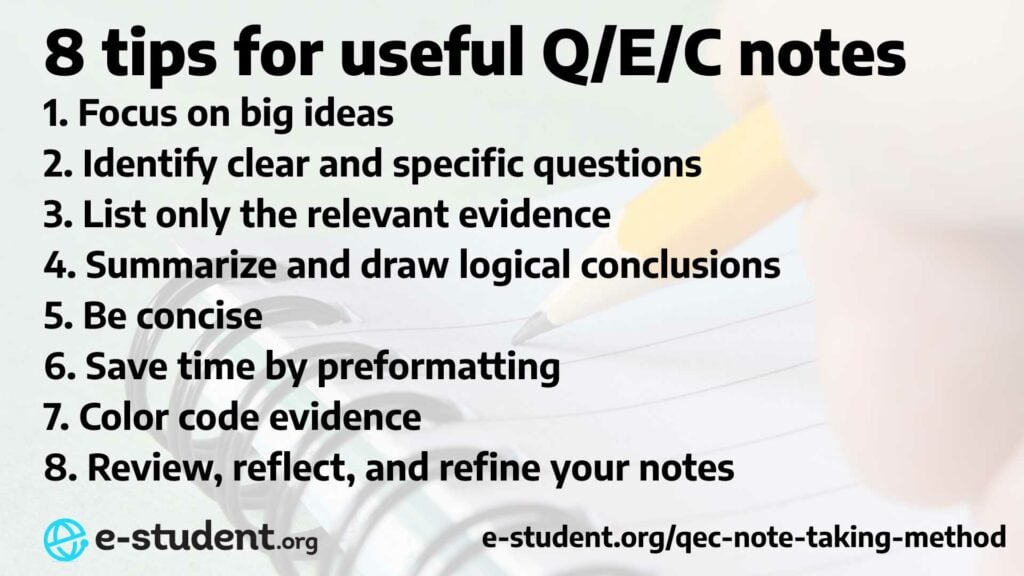- The Question/Evidence/Conclusion notetaking method is a straightforward way to help you connect ideas presented in class in the form of questions and answers.
- The method is particularly useful in argumentative subjects such as philosophy, history, and literature, as well as for drafting essays.
- It encourages clear structure and critical reflection of arguments, and provides a useful tool for revision.
Have you noticed that your lecturers tend to present in a particular way, posing a question and then presenting the response? What if there was a method for note-taking that matched how academics often think and structure their presentations that could help you make sense of and remember the ins and outs of the topic at hand? The Q/E/C method of notetaking does just that and can be a straightforward and important addition to your toolset for note-taking – especially for the humanities or other non-technical subjects.
Table of Contents
What is the Q/E/C method of note-taking?
The Question/Evidence/Conclusion notetaking method – abbreviated as Q/E/C or sometimes just QEC – is a simple but powerful method for organizing and recording information in your classes. Focused on capturing the big ideas and how they relate to each other, the method is structured around concepts that require arguing and evidence to create a clear and concise summary. Each concept is divided up into three parts: question, evidence, and conclusion.

While there are no studies that have looked specifically on the effectiveness of the Q/E/C method, it’s a favored method of author Cal Newport, who proposes this as the primary method to use for non-technical classes in his book How to Become a Straight-A Student. Numerous universities also recommend the method in their student guidance.
The method is also an excellent way to outline or plan for your essays, as it helps you develop a clear structure and will likely help you identify additional questions and counterarguments along the way that you may need to consider.
For what types of subjects is the Q/E/C method suitable?
The Q/E/C is ideally suited for most subjects in the humanities, especially ones that tend to present in an argumentative form, such as history, philosophy, and literature. Other subjects in the humanities, such as anthropology, can often follow a less argumentative structure, making it important to consider other note-taking methods as well. It is also suitable for much of the social sciences but use it more judiciously. Even in more technical subjects, there will often be topics where there is no consensus or problems are posed as open-ended questions, and the Q/E/C notetaking method will be useful to have ready to deploy.
For classes where the lecturer is presenting in a structured manner (which will more often than not be the case for pre-recorded online classes), you’ll often be able to use the Q/E/C method directly during class and end up with reasonably clean notes afterward.
For those lecturers that seem to speak in more of a stream-of-consciousness style, you’ll most likely want to try to capture as much as possible using another less structured method during class, such as the sentence notetaking method. Then after class, as you would normally do for the Cornell method, review and reformat your notes into questions, evidence, and conclusions.
Advantages and disadvantages of the Q/E/C method
There are both significant benefits and drawbacks to the Q/E/C method. It’s not a universal method that should be used for all lectures and subjects. This also goes for the subjects where it is the best suited, such as philosophy and history – make sure you know of other note-taking methods so you can choose the most effective one for the task at hand to get the most benefit from your note-taking.
These are the primary advantages of the Q/E/C method:
- Helps you focus on the bigger picture
- Helps you keep track of the relationship between the overall topic and the arguments/evidence
- An excellent way to clearly record more argumentative presentations
- Clear way of presenting arguments and counterarguments
- Forces you to synthesize arguments and write a conclusion
- A good fit for the humanities and non-technical subjects
- Matches the way many lecturers present (and view the world)
- Useful method for outlining argumentative essays
On the other hand, these are the main disadvantages of the Q/E/C method:
- Less suitable for technical subjects or for concepts with more complex relationships
- Challenging to use during fast-paced or poorly structured lectures
- Requires concentration and reflection
- Can be difficult to use if you don’t yet have an overall grasp of a new subject
How to take notes with the Q/E/C method
To take and use notes with the mapping method, follow these steps:
Prepare to take notes
If taking notes by hand, start with a blank paper, pen or pencil (I recommend the Blackwing 602), and a set of highlighters if you’d like to add some color (the Zebra Pen Mildliners are a great option).
Some prefer to preformat sheets with sections for each of the stages. In this case, you’ll want to draw lines at the following intervals:
- Question: an eighth of the page (about an inch or 2.5 cm for A4 or letter size)
- Evidence: 5 eights of the page (about 5 inches or 12.5 cm
- Conclusion: a quarter of the page (about 2 inches or 5 cm)
Adjust these measurements to best fit your writing style. Label each section appropriately and add color if you like.
If taking notes using a computer, you might want to save time by creating a page template that you can copy to save time and not have to write out and format headers during class. Alternatively, you may want to set up shortcuts in your word processor for each of the headings. Or if you don’t mind if your notes look messy at the end of your class, just make sure you budget time afterward to clean up the formatting.
Formulate the question
The starting point for each Q/E/C note is the question (unless a lecturer happens to start with the conclusion and work her or his way backward through an argument!)
If the lecturer is already structuring a class by stating the questions, this stage is easy – just follow their lead.
For example, if we’re taking an introductory 20th-century history class, it will cover the start of World War I. We’ve prepared an example question for this to illustrate the method (we also have additional examples at the bottom of this article).

If you have to interpret the lecturer or if you’re writing notes outside of a lecture, the important thing is to try to formulate the questions at an appropriate level. Too wide, and you may end up with too much evidence that you need to capture. Too narrow, and you will end up with too many questions, and you may fail to see the big picture. There are no hard and fast rules here, as the appropriate scope of the question will depend on the scope and level of detail of the class.
Remember that the note-taking format is mainly suitable for more argumentative questions. While it wouldn’t hurt you to use the Q/E/C method for a question like “What are the three main parts of the brain?”, there is no argumentation or conclusion needed for this kind of question, and there are more suitable note-taking methods in this case.
Note also that it can be a useful exercise, especially if using the Q/E/C method to outline an essay or if a lecture is on a well-defined topic or problem, to create a question for the exercise or lecture as a whole to help you grasp the bigger picture.
If you’re pressed for time during the lecture or it’s not clear what the questions should be, wait with this stage until after class and focus instead on steps 2 and 3.
Add the supporting evidence
Next, you will have to add the evidence or arguments that help answer the question.
The most important thing is to try to keep the evidence at a level where you don’t get too bogged down in details. Aim for brief bullet points. If you have another source of more detailed notes, you may want to only use keywords. If these are your primary notes, you’ll likely want to add a bit more detail.
In our example from the history class, the evidence might look like this for what caused World War I:
- Nationalism and competing imperialistic ambitions of European nations played a major role in the outbreak of war.
- Economic rivalries and the system of alliances between countries also contributed to the build-up to war.
- Assassination of Archduke Franz Ferdinand of Austria-Hungary in 1914 was the immediate trigger of the war.

Note that all the evidence you include does not need to point in the same direction – it is a good idea to include major counterarguments that are covered in the lecture also.
Write the conclusion
The final step is to write the conclusion, answering the question and based on the evidence. Try to summarize the main points. In case of arguments pointing in different directions, try to figure out where the evidence lands you while noting that there are differing views.
If using the notetaking method in class, the lecturer will usually have done this work for you, so you’ll want to try to capture this on the spot.
Going back to our example from the history class, the conclusion might look something like this:

If you’re using this method during class and it’s unclear what the conclusion is, this can be a useful cue that you should raise your hand and ask the lecturer to clarify. The lecturer might have left it open on purpose, however, and it will be your job to try to formulate a conclusion.
Either while or after you have written the conclusion, it can also be a good idea to revisit the arguments with highlighters to categorize the evidence. If the evidence is simply for and against something, use two colors (for example, red and green). If more complex, you may want to group the types of evidence using different colors.
Studying with your Q/E/C notes
Like all note-taking, the most important thing is to actually use your notes when revising. The Q/E/C method has the benefit of creating a valuable study resource that you can use ahead of exams or presentations.
When revising, start by covering everything except the question and try to outline as much as possible of the evidence, as well as the conclusion. You’ll get the best results if you can do this out loud (unless you’re studying in the library!) – this is true for written exams, but even more so if you are preparing for a presentation or an overall exam. Try to sound confident and clear when presenting. After a first attempt, read through your written evidence and conclusion, and then try again.
Tips for useful Q/E/C notes
Here’s a summary of my main tips for ensuring that your Q/E/C notes are as effective as possible for your studies:
- Focus on big ideas: Don’t transcribe what the lecturer is saying – especially for the evidence.
- Clear and specific questions: The question should be clear and specific and should focus on a specific topic or issue.
- List only the relevant evidence: The evidence should be relevant to the question and should support the conclusion. Avoid going off on tangents in your notes.
- Summarize and draw logical conclusions: The conclusion should be a logical and coherent summary of the evidence presented. It should be directly related to the question and should not contain any new information.
- Be concise: Be concise and avoid irrelevant information to make it easier to understand the main points.
- Save time by preformatting: Make sure you don’t waste time in class by having to format your paper or notes document.
- Color code evidence: If there is different kinds of evidence, or arguments and counterarguments, use colors to group and identify them.
- Review, reflect, and refine: Once you’ve had a chance to reflect more on the content, you’ll often want to refine your notes afterward and add or improve evidence and adjust the conclusion. Reflecting and refining has been shown to help with retaining information, developing a deeper understanding of the topic, and identifying the relevant connections.

As we’ve seen, the Q/E/C method is a straightforward but powerful method to help you structure your notes – and your thoughts – so that you can make sense of what can often seem like an overwhelming amount of information that you are faced with in your studies. With this method in your toolbox, head over to our list of other recommended note-taking methods to make sure you can face anything that your classes may throw at you.
Additional example notes using the Q/E/C method
To help you get a better idea of what Q/E/C notes can look like, we’ve also included a few additional examples from different subjects below.
Literature studies
- The novel explores the theme of the individual's struggle against societal norms and expectations.
- The protagonist of the novel is a non-conformist who defies the expectations of their family and community.
- The novel also touches on the theme of the consequences of rebellion and the cost of freedom.
Sociology
- Studies have shown that students from lower socioeconomic backgrounds are more likely to attend underfunded and under-resourced schools.
- Children from lower social classes are also less likely to have access to high-quality education, and are more likely to drop out of school.
- Higher social class is positively correlated with better educational outcomes, including higher graduation rates and better access to higher education.
Philosophy
- Some philosophers argue that human actions are determined by prior causes and external factors, making the concept of free will an illusion.
- Other philosophers argue that human beings possess free will, as they have the ability to make choices and act on them.
- Some philosophers propose a compatibilist view, which holds that free will is compatible with determinism, as long as the choices are made voluntarily.



